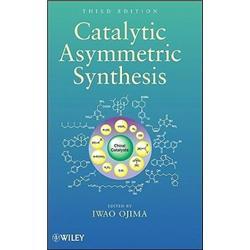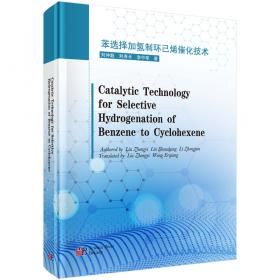Catalytic Air Pollution Control: Commercial Technology, 3Rd Edition
出版时间:
2009-02
版次:
1
ISBN:
9780470275030
定价:
1054.00
装帧:
精装
开本:
16开
纸张:
胶版纸
页数:
522页
-
Catalytic Air Pollution Control: Commercial Technology is theprimary source for commercial catalytic air pollution controltechnology, offering engineers a comprehensive account of allmodern catalytic technology. This Third Edition covers all the newadvances in technology in automotive catalyst control technology,diesel engine catalyst control technology, small engine catalystcontrol technology, and alternate sustainable fuels for auto anddiesel. Preface.
ACKNOWLEDGEMENTS.
ACKNOWLEDGEMENTS, FIRST EDITION.
ACKNOWLEDGEMENTS, SECOND EDITION.
I. FUNDAMENTALS.
1. Catalyst Fundamentals.
1.1 Introduction.
1.2 Catalyzed Verses Non-Catalyzed Reactions.
1.3 Catalytic Components.
1.4 Selectivity.
1.5 Promoters and their Effect on Activity and Selectivity.
1.6 Dispersed Model for Catalytic Component on Carrier: Pt onAl2O3.
1.7 Chemical and Physical Steps in Heterogeneous Catalysis.
1.8 Practical Significance of knowing the Rate-Limiting Step.
2. The Preparation of Catalytic Materials: Carriers, ActiveComponents, and Monolithic Substrates.
2.1 Introduction.
2.2 Carriers.
2.3 Making the Finished Catalyst.
2.4 Nomenclature for Dispersed Catalysts.
2.5 Monolithic Materials as Catalyst Substrates.
2.6 Preparing Monolithic Catalysts.
2.7 Catalytic Monoliths.
2.8 Catalyzed Monoliths Nomenclature.
2.9 Precious Metal Recovery from Monolithic Catalysts.
3. Catalyst Characterization.
3.1 Introduction.
3.2 Physical Properties of Catalysts.
3.3 Chemical and Physical Morphology Structures of CatalyticMaterials .
3.4 Techniques for Fundamental Studies.
4. Monolithic Reactors for Environmental Catalysis.
4.1 Introduction.
4.2 Chemical Kinetic Control.
4.3 The Arrhenius Equation and Reaction Parameters.
4.4 Bulk Mass Transfer.
4.5 Reactor Bed Pressure Drop.
4.6 Summary.
5. Catalyst Deactivation.
5.1 Introduction.
5.2 Thermally Induced Deactivation.
5.3 Poisoning.
5.4 Washcoat Loss.
5.5 General Comments on Deactivation Diagnostics in MonolithicCatalysts for Environmental Applications.
II. MOBILE SOURCE.
6. Automotive Catalyst.
6.1 Emissions and Regulations.
6.2 The Catalytic Reactions for Pollution Abatement.
6.3 The Physical Structure of the Catalytic Converter.
6.4 First-Generation Converters: Oxidation Catalyst(1976-1979).
6.5 NOx, CO and HC Reduction: The Second Generation: The Three WayCatalyst (1979 - 1986).
6.6 Vehicle Test Procedures (U.S., European and Japanese).
6.7 NOx, CO and HC Reduction: The Third Generation (1986 -1992).
6.8 Palladium TWC Catalyst: The Fourth Generation(Mid-1990s).
6.9 Low Emission Catalyst Technologies.
6.10 Modern TWC Technologies for the 2000s.
6.11 Towards a Zero-Emission Stoichiometric Spark-IgnitVehicle.
6.12 Engineered Catalyst Design.
6.13 Lean-Burn Spark-Ignited Gasoline Engines.
7. Automotive Substrates.
7.1 Introduction to Ceramic Substrates.
7.2 Requirements for Substrates.
7.3 Design Sizing of Substrates.
7.4 Physical Properties of Substrates.
7.5 Physical Durability.
7.6 Advances in Substrates.
7.7 Commercial Applications.
7.8 Summary.
8. Diesel Engine Emissions.
8.1 Introduction.
8.2 Worldwide Diesel Emission Standards.
8.3 NOx-Particulate Tradeoff.
8.4 Analytical Procedures for Particulates.
8.5 Particulate Removal.
8.6 NOX Reduction Technologies.
8.7 2007 Commercial System Designs (PM Removal Only).
8.8 2010 Commercial System Approaches under Development (PM and NOxRemoval).
8.9 Retrofit and Off-Highway.
8.10 Natural Gas Engines.
9. Diesel Catalyst Supports and Particulate Filters.
9.1 Introduction.
9.2 Health Effects of Diesel Particulate Emissions.
9.3 Diesel Oxidation Catalyst Supports.
9.4 Design/Sizing of Diesel Particulate Filter.
9.5 Regeneration Techniques.
9.6 Physical Properties and Durability.
9.7 Advances in Diesel Filters.
9.8 Applications.
9.9 Summary.
10. Ozone Abatement within Jet Aircraft.
10.1 Introduction.
10.2 Ozone Abatement.
10.3 Deactivation.
10.4 Analysis of In-Flight Samples.
10.5 New Technology.
III. STATIONARY SOURCES.
11. Volatile Organic Compounds.
11.1 Introduction.
11.2 Catalytic Incineration.
11.3 Halogenated Hydrocarbons.
11.4 Food Processing.
11.5 Wood Stoves.
11.6 Process Design.
11.7 Deactivation.
11.8 Regeneration of Deactivated Catalysts.
12. Reduction of NOx.
12.1 Introduction.
12.2 Nonselective Catalytic Reduction of NOx.
12.3 Selective Catalytic Reduction of NOx.
12.4 Commercial Experience.
12.5 Nitrous Oxide (N2O).
12.6 Catalytically Supported Thermal Combustion.
13. Carbon Monoxide and Hydrocarbon Abatement from GasTurbines.
13.1 Introduction.
13.2 Catalyst for CO Abatement.
13.3 Non-Methane Hydrocarbon (NMHC) Removal.
13.4 Oxidation of Reactive Hydrocarbons.
13.5 Oxidation of Unreactive Light Paraffins.
13.6 Catalyst Deactivation.
14. Small Engines.
14.1 Introduction.
14.2 Emissions.
14.3 EPA Regulations.
14.4 Catalyst for Handheld and Nonhandheld Engines.
14.5 Catalyst Durability.
IV.NEW AND EMERGING TECHNOLOGIES.
15. Ambient Air Cleanup.
15.1 Introduction.
15.2 Premair?Catalyst Systems.
15.3 Other Approaches.
16. Fuel Cells and Hydrogen Generation.
16.1 Introduction.
16.2 Low-Temperature PEM Fuel Cell Technology.
16.3 The Ideal Hydrogen Economy.
16.4 Conventional Hydrogen Generation.
16.5 Hydrogen Generation from Natural Gas for PEM Fuel Cells.
16.6 Other Fuel Cell Systems.
INDEX.
-
内容简介:
Catalytic Air Pollution Control: Commercial Technology is theprimary source for commercial catalytic air pollution controltechnology, offering engineers a comprehensive account of allmodern catalytic technology. This Third Edition covers all the newadvances in technology in automotive catalyst control technology,diesel engine catalyst control technology, small engine catalystcontrol technology, and alternate sustainable fuels for auto anddiesel.
-
目录:
Preface.
ACKNOWLEDGEMENTS.
ACKNOWLEDGEMENTS, FIRST EDITION.
ACKNOWLEDGEMENTS, SECOND EDITION.
I. FUNDAMENTALS.
1. Catalyst Fundamentals.
1.1 Introduction.
1.2 Catalyzed Verses Non-Catalyzed Reactions.
1.3 Catalytic Components.
1.4 Selectivity.
1.5 Promoters and their Effect on Activity and Selectivity.
1.6 Dispersed Model for Catalytic Component on Carrier: Pt onAl2O3.
1.7 Chemical and Physical Steps in Heterogeneous Catalysis.
1.8 Practical Significance of knowing the Rate-Limiting Step.
2. The Preparation of Catalytic Materials: Carriers, ActiveComponents, and Monolithic Substrates.
2.1 Introduction.
2.2 Carriers.
2.3 Making the Finished Catalyst.
2.4 Nomenclature for Dispersed Catalysts.
2.5 Monolithic Materials as Catalyst Substrates.
2.6 Preparing Monolithic Catalysts.
2.7 Catalytic Monoliths.
2.8 Catalyzed Monoliths Nomenclature.
2.9 Precious Metal Recovery from Monolithic Catalysts.
3. Catalyst Characterization.
3.1 Introduction.
3.2 Physical Properties of Catalysts.
3.3 Chemical and Physical Morphology Structures of CatalyticMaterials .
3.4 Techniques for Fundamental Studies.
4. Monolithic Reactors for Environmental Catalysis.
4.1 Introduction.
4.2 Chemical Kinetic Control.
4.3 The Arrhenius Equation and Reaction Parameters.
4.4 Bulk Mass Transfer.
4.5 Reactor Bed Pressure Drop.
4.6 Summary.
5. Catalyst Deactivation.
5.1 Introduction.
5.2 Thermally Induced Deactivation.
5.3 Poisoning.
5.4 Washcoat Loss.
5.5 General Comments on Deactivation Diagnostics in MonolithicCatalysts for Environmental Applications.
II. MOBILE SOURCE.
6. Automotive Catalyst.
6.1 Emissions and Regulations.
6.2 The Catalytic Reactions for Pollution Abatement.
6.3 The Physical Structure of the Catalytic Converter.
6.4 First-Generation Converters: Oxidation Catalyst(1976-1979).
6.5 NOx, CO and HC Reduction: The Second Generation: The Three WayCatalyst (1979 - 1986).
6.6 Vehicle Test Procedures (U.S., European and Japanese).
6.7 NOx, CO and HC Reduction: The Third Generation (1986 -1992).
6.8 Palladium TWC Catalyst: The Fourth Generation(Mid-1990s).
6.9 Low Emission Catalyst Technologies.
6.10 Modern TWC Technologies for the 2000s.
6.11 Towards a Zero-Emission Stoichiometric Spark-IgnitVehicle.
6.12 Engineered Catalyst Design.
6.13 Lean-Burn Spark-Ignited Gasoline Engines.
7. Automotive Substrates.
7.1 Introduction to Ceramic Substrates.
7.2 Requirements for Substrates.
7.3 Design Sizing of Substrates.
7.4 Physical Properties of Substrates.
7.5 Physical Durability.
7.6 Advances in Substrates.
7.7 Commercial Applications.
7.8 Summary.
8. Diesel Engine Emissions.
8.1 Introduction.
8.2 Worldwide Diesel Emission Standards.
8.3 NOx-Particulate Tradeoff.
8.4 Analytical Procedures for Particulates.
8.5 Particulate Removal.
8.6 NOX Reduction Technologies.
8.7 2007 Commercial System Designs (PM Removal Only).
8.8 2010 Commercial System Approaches under Development (PM and NOxRemoval).
8.9 Retrofit and Off-Highway.
8.10 Natural Gas Engines.
9. Diesel Catalyst Supports and Particulate Filters.
9.1 Introduction.
9.2 Health Effects of Diesel Particulate Emissions.
9.3 Diesel Oxidation Catalyst Supports.
9.4 Design/Sizing of Diesel Particulate Filter.
9.5 Regeneration Techniques.
9.6 Physical Properties and Durability.
9.7 Advances in Diesel Filters.
9.8 Applications.
9.9 Summary.
10. Ozone Abatement within Jet Aircraft.
10.1 Introduction.
10.2 Ozone Abatement.
10.3 Deactivation.
10.4 Analysis of In-Flight Samples.
10.5 New Technology.
III. STATIONARY SOURCES.
11. Volatile Organic Compounds.
11.1 Introduction.
11.2 Catalytic Incineration.
11.3 Halogenated Hydrocarbons.
11.4 Food Processing.
11.5 Wood Stoves.
11.6 Process Design.
11.7 Deactivation.
11.8 Regeneration of Deactivated Catalysts.
12. Reduction of NOx.
12.1 Introduction.
12.2 Nonselective Catalytic Reduction of NOx.
12.3 Selective Catalytic Reduction of NOx.
12.4 Commercial Experience.
12.5 Nitrous Oxide (N2O).
12.6 Catalytically Supported Thermal Combustion.
13. Carbon Monoxide and Hydrocarbon Abatement from GasTurbines.
13.1 Introduction.
13.2 Catalyst for CO Abatement.
13.3 Non-Methane Hydrocarbon (NMHC) Removal.
13.4 Oxidation of Reactive Hydrocarbons.
13.5 Oxidation of Unreactive Light Paraffins.
13.6 Catalyst Deactivation.
14. Small Engines.
14.1 Introduction.
14.2 Emissions.
14.3 EPA Regulations.
14.4 Catalyst for Handheld and Nonhandheld Engines.
14.5 Catalyst Durability.
IV.NEW AND EMERGING TECHNOLOGIES.
15. Ambient Air Cleanup.
15.1 Introduction.
15.2 Premair?Catalyst Systems.
15.3 Other Approaches.
16. Fuel Cells and Hydrogen Generation.
16.1 Introduction.
16.2 Low-Temperature PEM Fuel Cell Technology.
16.3 The Ideal Hydrogen Economy.
16.4 Conventional Hydrogen Generation.
16.5 Hydrogen Generation from Natural Gas for PEM Fuel Cells.
16.6 Other Fuel Cell Systems.
INDEX.
查看详情

暂无旧书在售

 占位居中
占位居中





